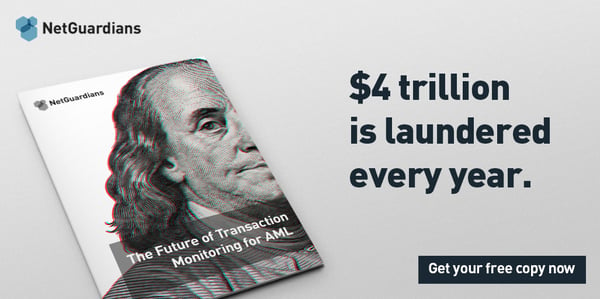New AML software from NetGuardians is a game-changer for stopping criminals using the financial system to clean their cash, write Jerusha Pegg and Jérôme Kehrli.
Money laundering is big business. According to the UN, some 5 percent of the world’s wealth is laundered by criminals every year – that’s up to $2 trillion in the pockets of drug and arms smugglers, terrorists, people traffickers and thieves.
As the cogs of the global financial infrastructure, banks and other financial institutions are the unwitting laundromats. In what has become a game of cat-and-mouse, never has there been more pressure on them to spot and report money laundering. Every year, we see more regulations and bigger fines. In July, Deutsche Bank was fined $186m for its anti-money laundering (AML) failures.
But still criminals launder their gains unabated. One researcher from Melbourne’s La Trobe University found that just 0.1 percent of laundered money is recovered. Clearly, the criminals know how to evade detection.
Layering and how it works
In a process known as ‘layering,’ money launderers move their money many times, making it hard to follow. They pass it through multiple banks and financial institutions, smurfing (splitting the sums up into smaller amounts) the cash through money mules and buying and selling assets. They also know the ‘rules’ used to detect suspicious activity and make sure they remain within them each time they move their money.
Part of the problem is that banks must carefully calibrate their AML rules so they don’t stop lots of non-suspicious transactions but do spot the highly suspicious ones. Go too tough and they add expense and friction; go too easy and they miss the crime.
Typically, the rules set upper limits on transfers, identify high-risk destinations and match incoming sums with those outgoing. But the simple fact that banks use known parameters means criminals know what to avoid doing. And every time banks add new rules, criminals adjust their behavior accordingly.
If money laundering is to be tackled effectively, spotting it must be rethought.
A sophisticated software solution
At NetGuardians, we’ve developed software that uses machine learning and artificial intelligence to look at thousands of data points associated with a transaction. We’ve built models that pick up signals too faint for human investigation to spot, but that are proving highly effective at identifying money-laundering activity. Not only is our software finding all known money-laundering incidents in historic data sets we test it on, but plenty of unknown incidents, too. And as it learns as it works, the models adapt in real time to the constantly evolving behavior of the criminals.
Such accuracy has another benefit – it throws up fewer alerts by several orders of magnitude. This is important for two reasons. It saves the bank time and money investigating the alerts – false and positive – and it reduces the amount of noise around the data it gives to the authorities when it finds suspicious activity. This, in turn, makes the authorities’ job of investigating the flagged transactions and any linked transactions faster, making it more likely the criminals will be apprehended. Given that banks have been fined not just for their unwitting part in money laundering, but also for poor reporting of suspicious activity, this is a valuable double win.
In addition, our software features advanced dashboards aimed at streamlining the investigation process, significantly improving the operational efficiency of the investigation teams. But the real value-add of the NetGuardians AML solution is that it can be used anywhere along the layering process. So even if a bank is used just once to clean the cash, our software can identify the risk and the bank can alert the authorities.
Critically, our software is a game-changer as it can also spot money laundering more accurately as ill-gotten cash arrives in the financial system, and at the final placement stage, when it is extracted as ‘clean.’ This changes the game to detecting money laundering activity more accurately.
Banks rightly have strict obligations to look for and report possible money laundering. They’re fined if they do it badly and they can be fined if they report historic incidents. Banks using NetGuardians software are effectively protected in both instances as their AML reporting is clean and fast.
Jerusha Pegg is the AML Product Manager at NetGuardians
Jérôme Kehrli is the Chief Technology Officer at NetGuardians



